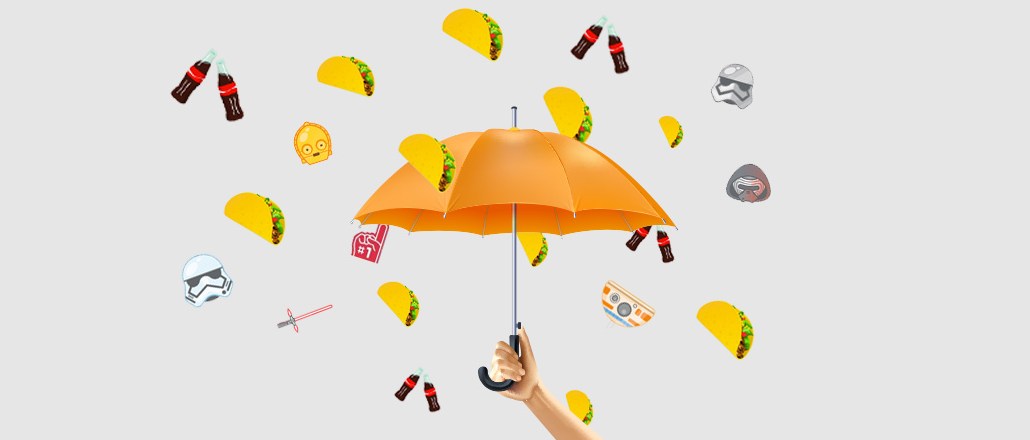Save 50% on a 3-month Digiday+ membership. Ends Dec 5.

Brands have reached peak emoji.
Any big brand who could possibly sell to millennials has tried to shoehorn emojis into their marketing. Taco Bell got a taco emoji made. Burger King celebrated the return of chicken fries to its menu by rolling out a chicken-themed emoji keyboard. Chevrolet wrote a press release in emojis. Coca-Cola, Star Wars, Dove and Toyota all have custom emojis on Twitter. At least 250 brands created their own emoji keyboards in 2015.
Leave it to marketers to take something fun and make it yet another dubious marketing tactic that makes for a good press release and evidence of being “hip” but not much more. There’s a reason brands like to trumpet the release of emoji keyboards but never how many people actually use them regularly.
“2015 potentially saw an overload of poor emoji integrations that didn’t add much value — I do think it was a bit of an overload,” said John Ohara, svp of strategy at Giant Spoon. “A lot of brands moved into the space too quickly, and ended up neither being true to their core brand identity nor adding to it in a meaningful way.”


People love emojis because they humanize boring text and social media posts. But when every brand from Holiday Inn Express to Ikea and even the Pope deploy them, it begins to feel forced. The White House, for instance, realized that the hard way, when it incorporated emojis into a report about millennials — only to later remove them after the very millennials they were attempting to reach balked.
Ad position: web_incontent_pos1
“While it is important for brands to keep on top of trends, and even fads, it’s as important knowing when to stop,” said Marlene Morris Towns, professor of marketing at Georgetown University’s McDonough School of Business. “You never want to be the last person leaving the party. Brands using emojis at this point is like politicians dancing to ‘Nae Nae’ — It’s so last year.”
It’s not like emojis never work, though. Initially, they helped brands touch a chord with their customers, who got a kick out of the novelty of branded emojis.
“There’s nothing wrong with experimenting with new trends, as long as it fits within your strategy,” said Joe McCaffrey, head of social media at Huge. “But there’s a difference between chasing a shiny object and really evaluating the opportunity. You have to do your research and be sure you’re adding some value or utility.”
Some brands have succeeded in adding some of that utility, like Domino’s, which let customers order a pie just by tweeting a pizza slice emoji. GE linked emojis to science experiments as a part of its #EmojiScience campaign. Dove managed to create some buzz around its curly hair emoji keyboard because “it was authentic to our brand’s Love Your Curls campaign and overall mission,” said Rob Candelino, Unilever’s vp of marketing- haircare for Dove.
But emojis need to be grounded in data and targeting the right people.
Ad position: web_incontent_pos2
“Data needs to underpin everything brands are doing today,” said Nelson Freitas, chief strategy officer at Wunderman. “You can’t focus on trends blindly, it’s important to understand your demographic and then target them through means specifically tailored to them — whether it is emojis or anything else.”
There are early indications that brands have started moving away from emoji keyboards and stickers, and are beginning to “climb the media stack” on messaging platforms, according to Snaps CEO Christian Brucculeri. Swyft Media’s Wray agreed, saying that brands were embracing other options, calling emoji keyboards “just the first step in the education process of brands” to get acquainted with the world of messaging apps.
Brands are beginning to branch out towards creating branded profiles and pushing out in-app videos on platforms like Kik and Whatsapp among others. “It’s the obvious next step in terms of scale,” said Swyft Media co founder Evan Wray, with the brands registering up to 50,000 downloads for emoji keyboards a day as opposed to “hundreds of thousands” of downloads a day for other offerings. L’Oreal, for instance, saw much more engagement when it pushed out branded frames instead of emojis on picture editing apps recently.
In other words, look for Burger King to say hi to you on Kik instead of pushing you to download a branded keyboard.
More in Marketing

Ulta, Best Buy and Adidas dominate AI holiday shopping mentions
The brands that are seeing the biggest boost from this shift in consumer behavior are some of the biggest retailers.

U.K. retailer Boots leads brand efforts to invest in ad creative’s data layer
For media dollars to make an impact, brands need ad creative that actually hits. More CMOs are investing in pre- and post-flight measurement.

‘AI is permeating everything we do’: How Guitar Center developed 2 AI tools this year
This summer, the company launched a chatbot called Rig Advisor to help customers find the right instruments and products.
Ad position: web_bfu
